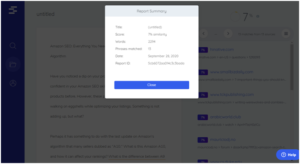Have you noticed a dip in your product rankings recently? You are confident in your Amazon SEO skills and have ranked a few of your products before. However, these past few months, you have been walking on eggshells while optimizing your listings. Something is not adding up, but what is it?
Perhaps it has something to do with the latest update on Amazon’s algorithm that many sellers dubbed as “A10.” What is this Amazon A10, and how it can affect your rankings? What is the difference between A9 and A10? Let us clear things up in this article.
Hello, A10? Goodbye, A9?
Amazon hasn’t announced a name change in their algorithm yet, so it is still called A9. But undoubtedly, there has been a change — or perhaps changes — in its ranking factors. As a seller, you must be aware of the ongoing and sudden updates in the marketplace.
Amazon is the world’s second-largest search engine and sells over 350 million products. To get your product noticed, your listings must tick all the criteria of Amazon’s algorithm to get on top of the page results. It is not an easy feat because approximately 2.5 million third-party sellers also do it.
Unfortunately, there is no way to game the system, and if you dare do such a thing, your selling privileges might be revoked. In short, you can never sell on Amazon anymore, which is a huge loss because it is known as the largest online retail store worldwide.
This is why Amazon developed an algorithm to kick out bad players and award law-abiding sellers. Amazon A9 helps maintain the checks and balances in the marketplace. It also ensures that only relevant product listings are shown in the page results every time a buyer searches for a product.
If you still recall, since you have been doing a lot of tweaking to figure out the problem, Amazon A9 rank listings based on the following factors:
- Price
You must set up competitive pricing that your customers will love but won’t hurt your bottom line.
- Keyword relevance
We know that a short string of words decide whether A9 will favor your fate, so better conduct thorough keyword research. - Inventory availability
It’s fulfilling when you see your stock at zero because it means someone bought all your products. However, this has a negative implication on Amazon’s side, so you need to restock quickly. - Sales performance history
The stronger your sales performance history, the higher the chances that A9 will put your listings on page one.
It used to feel like hitting the jackpot when you manage to pass all of the criteria. Unfortunately, this is not the case anymore, and there are other conditions that you must meet.
9 Ranking Criteria of Amazon A10 algorithm

Amazon found out that buyers are more concerned about the search results’ accuracy than how profitable a product is. Now, the algorithm relies heavily on buyer searches more and not only on money-making products. They are one of the world’s most customer-centric companies, after all, and they will do anything to make their customers happy. For that reason, the following criteria were added in Amazon’s algorithm:
- PPC campaign sales
These are not as crucial as before, but the current algorithm update still considers them. - Impressions
This refers to how many times Amazon displays your PPC ad to the buyer on its partner sites and the marketplace. - Click through rate
Abbreviated as CTR, it is a metric that measures how frequently a listing is clicked every time the buyer sees it on the search results. - Conversion rate
Pertains to the percentage of buyers who viewed your product page and ordered your product. - Off-site sales
This means that your business is not only thriving inside the marketplace, but you are also winning on off-site traffic. - Sales internal
The sales that don’t need buyer intervention or searching, and usually come from the “frequently bought with” section. - Organic sales
These are not driven by any promotion or PPC ads as buyers willingly order your products from the search results. - Sales history
Pertains to how regularly your product is selling and how well-stocked your inventory is. - Seller authority
Pertains on how often you win the Buy Box or a product listing. Amazon considers several factors such as: feedback rating, performance metrics, how long you have been active on Amazon, and your product return history.
Tips on How to Upgrade your Amazon SEO Game Plan
Now that you are updated regarding Amazon A10’s ranking factors, your next move is to improve your Amazon SEO strategy.
Perform a keyword research

Ensure that you are using relevant keywords on your listing’s copy and place them in a way buyers can understand. You may be tempted to stuff your copy with keywords, but it will drive away potential customers because of how cringy the sentence structure will turn out. Always think of your customers when writing your product listing. Remember that search phrases are placed on the top four critical parts of a listing, such as a title, bullet points, product description, and backend keywords.
You may conduct keyword research in two ways:
- Using keyword research tools.
Here are our top picks:
- Keyword Scout of Jungle Scout
It uses the actual data from Amazon so you are assured that it only generates fresh and relevant keywords. It retrieves data points from different Amazon marketplaces located in the United States, Canada, United Kingdom, Mexico, Italy, Spain, Germany, and France. (Price: $19-$84 based on the plan).
- Keyword Tool Dominator
Besides finding Amazon keywords, it can also find YouTube, Bing, eBay, Etsy, Walmart, and Google search terms. This tool is great for searching for long-tail keywords. It is compatible with 18 Amazon marketplaces like Australia, Italy, Turkey, Brazil, Japan, UAE, Canada, Mexico, United Kingdom, Netherlands, China, France, Saudi Arabia, Germany, Singapore, India, Spain, and the United States. (Price: $48; one-time payment lifetime access).
- Sonar by Sellics
It has a database full of keywords searched by real Amazon shoppers, consisting of more than 180 million search terms. It supports various languages, and no sign up is required when you use it. (Price: FREE).
- Keyword Explorer Tool by Ahrefs
This generates keywords by phrase match, broad match, search suggestions, and more. It pulls data from different search engines such as Amazon, Google, YouTube, Bing, Yahoo, Yandex, Baidu, Daum, Naver, and Sezman, proving how efficient it is. (Price: starts at $99).
- Unicorn Smasher
Nope, we are not referring to an online game. The fancy term pertains to a powerful keyword research tool that you can easily integrate as a Chrome extension. No installation and sign up required. It is from the makers of AMZ Tracker. (Price: FREE).
- Getting it from an Amazon search term report.
According to Amazon Seller Central, this report “shows the most popular search terms on Amazon during a given period, along with each term’s search frequency rank and the top three products that customers (in aggregate) clicked on after searching that term.” In short, it is a gold mine of high-converting keywords that you can use to optimize your listings.
However, this is only available if you are the owner of the brand you are selling. To make this possible, you must be registered in Amazon Brand Registry. Perform the following steps to download the said report:
- Log into your Amazon Seller Central account.
- Go to Reports > Advertising Reports.
- Choose a campaign from the dropdown menu.
- In the Report type, select “Search term.”
- Select the duration in the Report period.
- In the Data unit, select “Total.”
- Type an appropriate report title in the Report name text box.
- Click Create a report to generate it.
- Once it is finished, you may now download the report.
After downloading the report, you may sort it according to the keywords that you need. You can try two different approaches. First is sorting the CR (Conversion Rate) column from highest to lowest to obtain the high-converting keywords. Another way is sorting the CTR (Click Through Rate) column from highest to lowest to filter relevant keywords.
Collate all keywords and put them in an excel spreadsheet. Now, you are armed with valuable search terms that you can use to optimize your product listings.
Optimize your product listings (once more)
You have been painstakingly doing this since you have noticed your rankings were getting lower, but do it again for the sake of organic sales. Let’s get real here. You won’t be diligent in optimizing your listings if it is not for the PPC campaigns you want the algorithm to notice.
It might be frustrating, but you have to do it to boost your sales and outsmart your competitors. Product listings are also a fundamental aspect that helps you win the Buy Box. You need fresh and relevant keywords since you are going back to the drawing board.
Here are the parts of your listing that need a makeover:
- Product title
Ensure that you insert the primary keyword along with the brand name, product, quantity, material, and color. Use the 250 character limit wisely and ensure that the buyer easily comprehends the title when they read it. - Bullet points
Buyers skim the listings, and will not waste their time reading through your copy word for word. This is where bullet points come in handy. You can write up to five of them, and make sure that you insert the keywords. This is the part where you can flaunt your product’s benefits and emphasize how they can help your customer. - Product description
You can expound on your bullet points more on this part, as it has a 2,000 character-limit (including spaces). Use both primary and secondary keywords but avoid stuffing them. Explain how you can solve your customer’s problems in a way that touches them emotionally, instead of using advertising jargon. - Backend keywords
This is also where the “hidden” keywords are located. But don’t be confused with the term because this is your secret weapon to increase your chances of being picked by A9. Avoid adding keywords that you have used in the title, bullet points, and product description. It also helps you save your ad budget and precious clicks because it can exclude your listing from irrelevant search terms that a buyer enters.
Enhance your product images

Maybe you’re not a professional photographer. Still, you may follow the tips below so you can achieve a desirable outcome.
- Focus only on the product, void of borders, props, text, or anything that could distract the buyer.
- Use only a white background (RGB 255, 255, 255) so that your images stand out.
- The product must occupy 85% of the image to increase clicks and boost organic traffic.
- Maximize the number of image slots per category to help the buyers make informed decisions.
- If applicable, indicate the scale or measurements of the product.
- Besides showing the product itself, try taking lifestyle photos where the product is used so that it will be more relatable.
- Make sure your images are at least 1000 pixels so buyers can scrutinize the image closely.
- Use different images for A+ content, like comparison charts and lifestyle photos.
Your product image is what the buyers first see when browsing items in the search results page, so make sure it is enticing and that it encourages conversions.
Drive traffic to your listings
You can do this by using your Amazon product listing link on your social media accounts, website, and blog. Here are other ways to attract customers to your listings:
- Let influencers promote your products if you have the budget
- Offer coupons such as a percentage off or Buy One Get One (BOGO), which are features you can access through Seller Central.
- Promote your products through crowdfunding by joining Amazon Launchpad.
- Try selling your products via email marketing, but avoid being too salesy.
Encourage healthy feedback

Positive reviews are not bought; instead, you must earn them legally. Amazon has a special page for customer product review guidelines that you should read. If you have failed to abide by the terms, you may face civil and criminal penalties, aside from suspension of your selling privileges.
You may request — we repeat — request a review by sending a follow-up email to users who bought your product. Don’t offer any monetary exchange. Also, prevent spamming your customers as it may lead to negative reviews because of too much aggressiveness.
Another way of getting reviews is by inserting a thank-you note inside your product’s package or box. You may add a line where you ask for a review. Moreover, you may encourage them to post their newly bought item on their social media account with a hashtag you can provide on the note. It is like hitting two birds with one stone.
Final Thoughts
Imagine being a carpenter who needs to sharpen his tools to be more efficient at work. This is the same when Amazon releases new updates to its A9 algorithm. As a seller, it is part of your job to keep yourself posted whenever this happens and learn how to deal with such changes. Luckily, you don’t have to start over because you only need to improve your current Amazon SEO skills. You may begin by following the tips above, and always prioritize your customers so you can continue thriving on the Amazon marketplace.
